Christine Aldridge Benson (née Jukes) (December 19, 1927 in Cannock, UK – July 10, 1995 Cannes, France) was an English portrait painter, surrealist and watercolorist. From Bournemouth, Dorset, UK, she traveled extensively in the Far East after she married. After divorcing she returned to the UK, before finally emigrating to the south of France for the last 25 years of her life.
Early life and Education

Christine Jukes was born in Cannock, Staffordshire, UK on December 19, 1927, to Arthur Edgar and Ethel Annie (née Bemister) Jukes. Unfortunately, she never knew her father as he died on January 14, 1928 from complications related to severe lung damage he sustained from mustard gas poisoning during WWI when he was a Lieutenant in the Tank Corps. At the time of his death, he was working as a personnel manager for the Cadbury company chocolate works in Bournville, Worcestershire. Her mother was the daughter of Samuel Edward Bemister, a businessman and seven time Mayor of Christchurch, Dorset.
After the death of her father, the family consisting of Ethel and her two daughters, Christine (known as Chris), and her older sister Sylvia, moved back to Christchurch and eventually settled in nearby Bournemouth. There in 1938, Ethel met and married Oliver Henry Butcher, a local Barclays bank manager. They moved to 5 Pine Mansion, Boscombe. Christine attended nearby Talbot Heath school for girls. After matriculating, she attended the Southern College of Art, Bournemouth from1942 to1946. At the age of eighteen, she dropped out of college after completing her national drawing certification and went to London, initially to stay with her sister but then lived independently at 24 Lancaster Terrace, High Park, London W2. She first worked as an assistant in a dress shop, but eventually got a job as a feature illustrator for the London Evening Standard and later at the Gaumont-British Publicity headquarters in Haymarket as a staff artist. While working she continued to take art classes in the evenings.
In 1948, after a falling out with a boyfriend, she traveled to Cape Town, South Africa to visit her sister Sylvia who, after qualifying as a nurse in London, had met and married doctor Hayden Roberts. In Cape Town, and later in Johannesburg, they established a maternity and pediatric clinic, eventually specializing in children with cerebral palsy. On the flight down, which took two days, Christine, now calling herself Tina, met her future husband Melvin Oliver “Benny” Benson. Benny was an overseas area manager for Pepsi Cola and he was on route to establish Pepsi bottling plants in Cape Town and Johannesburg. While in Cape Town, Christine worked as an illustrator for the Cape Times and then as an illustrator and part time model for the Fairweather fashion house.
Married Life
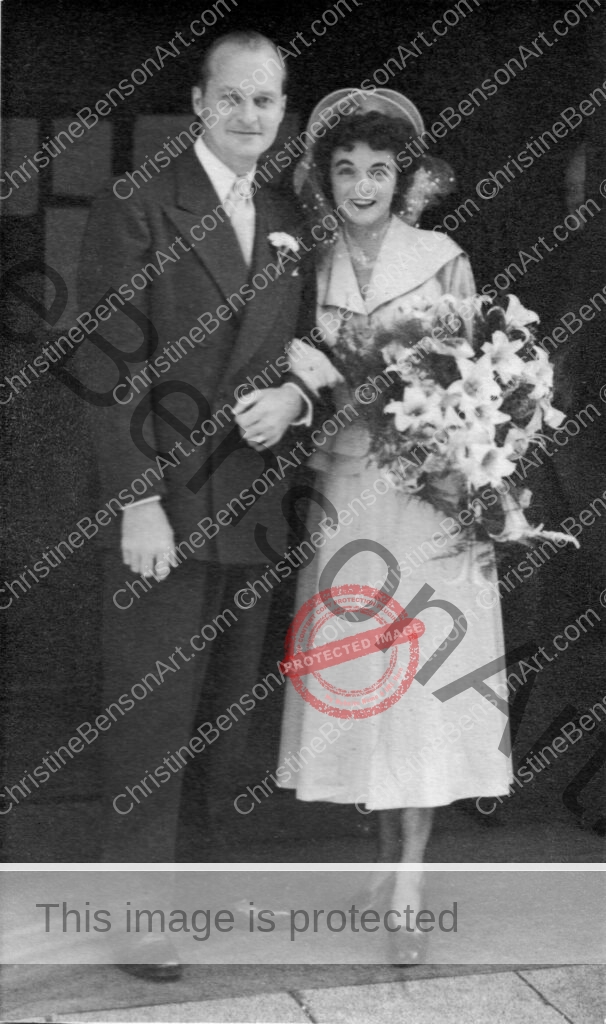
On February 5th, 1949, Christine and Benny were married in Johannesburg. After Christine became pregnant, Benny left his job and the family moved to Washington DC in December 1949, so that “his child would be born in the US and could grow up to become president if they wanted.” Unable to find a satisfactory new job, Benny joined the CIA to work with many of his former OSS colleagues from the War when he was a Major. In the OSS his first assignment had been working with the British in North Africa, after that he was the first American to operate behind enemy lines in Yugoslavia and later on he went on raids in occupied Norway, for which he received the Haakon VII Cross of Freedom to go with his Legion of Merit and British Africa Star.
Christine’s first son, Christopher Melvin Benson was born in May, 1950 and she became a fulltime mother. In 1951, Benny rejoined Pepsi Cola while covertly continuing to work for the CIA. The family moved to Stockholm, Sweden, in January 1952 where Benny was to establish another bottling plant. Here her second son Anthony Nels Benson was born in October, 1952. After a brief time in the UK, the family moved again, this time to Okinawa, Japan to expand Pepsi’s reach to that area and support the US military bases on the island. In 1955, after the bottling plant was built and up and running, Benny was assigned to start up a new plant on the main island in Yokohama. In each location Benny would have to recruit local investors, buy the land, get the bottling plant built and then train the locals to run the plant, this process usually took about two years.
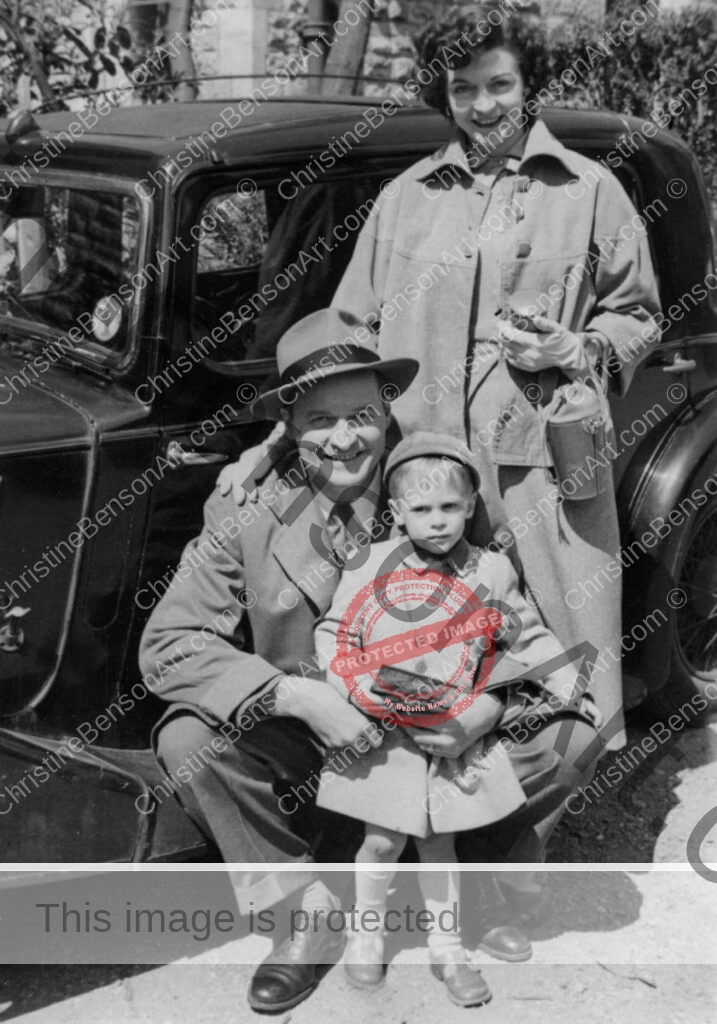
Christine took advantage of having household help in each country. This gave her the freedom to return to being creative and to learn some of the local art styles and techniques. She learnt Japanese style wood carving and Sumi painting technique which greatly influenced her watercolor style. In 1957, another assignment had the family moving to Bangkok, Thailand where Christine talked herself into the position of fashion editor for the Bangkok World. There she not only created the illustrations but also the fashion concepts and co-wrote the accompanying articles.
All the moves put a strain on the marriage. Each move meant Benny would go ahead to find a house and get things established, which left Christine behind to pack up the house and follow several months later with the children. Along with the seventeen year age difference, this was one of the contributing factors to their separation a year later. In 1958, Christine and her eldest son, Christopher, took the SS Himalaya back to the UK, leaving Anthony, then 5, alone with his father in Bangkok. Eventually, Anthony followed, flying back to the UK a few months later. After completing his assignment in Bangkok, Benny was relocated to Ghana to build a Pepsi plant in Accra. They attempted to reconcile when the whole family was together again for a few months during the summer. Several things contributed to the failure of the attempted reconciliation, all not helped by the added stress of her youngest son fracturing his elbow and two weeks later cutting his leg open which became infected with gangrene. Christine and the boys returned to England at the start of the school year.
Separation and Divorce, England
Back in England as a single parent with two small children, Christine worked at restarting her career as an artist in London. Competition was fierce and she decided to move back to her hometown of Bournemouth after Christopher had already started boarding school there. She thought it was better to be “a big fish in a small pond than a little fish in a big lake”. In 1958 Christine moved into a flat overlooking the cliffs and the English Channel, at #9 Riviera, East Overcliff Drive, not far from the boarding school where by now both sons attended. During this period she reverted to using her full name Christine and signed her paintings as Christine, although some were occasionally signed Tina. In 1961 one of her paintings was accepted in the Royal Academy Summer Salon.
The divorce was finalized in February 1963. At that time, all divorces in the UK required “grounds”, which in this case was listed as mental cruelty. Although ostensibly much of it was exaggerated or fabricated, it was still painful for the family.
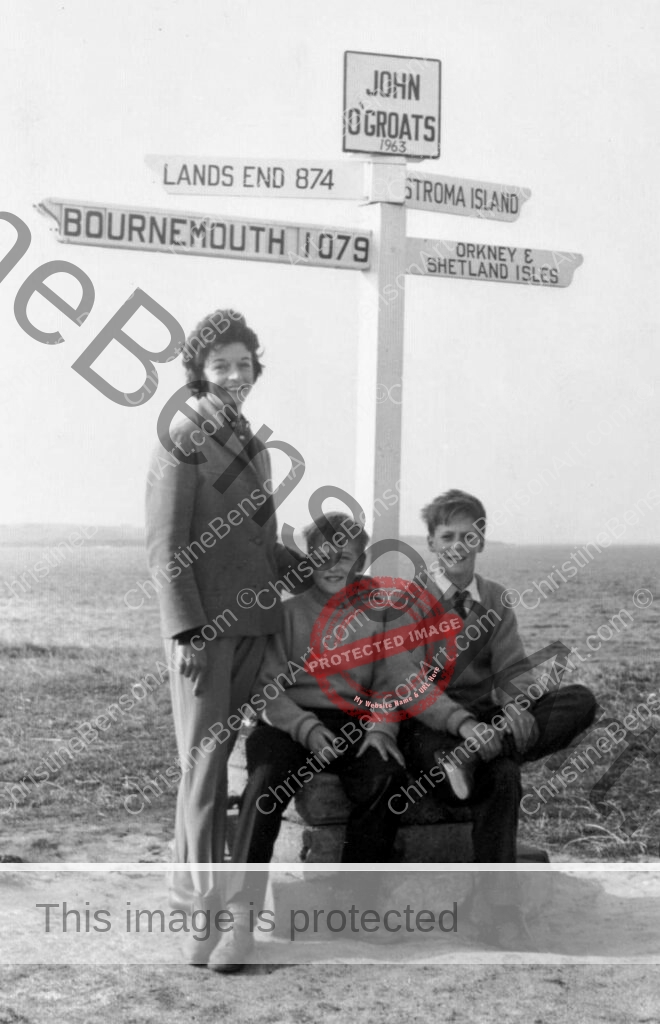
In Bournemouth, Christine worked hard to establish herself as a portrait painter, for example Dr. Whitehead, and as a tutor and lecturer at the Bournemouth Community Art Centre. Christine also created illustrations for advertisements in the local papers. Additionally, she painted her friends like Katie White, a fellow student from her Bournemouth College days. She managed to buy a small bungalow with some help from her stepfather and a big mortgage from the bank and in 1961, she moved into 10 Copsewood Avenue near Queens Park in Bournemouth. She tried to do most of her teaching and painting commissions during the school year while the boys were away and reverted to a mostly full time mother when the boys were home on holiday. During most Easter holidays, the family took a camping trip to various regions in the UK, first to Cornwall, then Wales, later Scotland and eventually Ireland. These travels were often reflected in some of her landscapes although with two active boys there was little time available. During the summers the boys often traveled to spend time with their father, first in Ibadan, Nigeria where Benny was working for the Agency for International Development, AID. Then in later years to Washington DC where Benny was a staff consultant for the Committee for Foreign Affairs for the US Congress. Whenever Benny traveled overseas, he managed to fit in a visit to the family in England. Christine and Benny remained on good terms and characterized their new relationship as one of friends.
In the summer of 1964, Christine was invited to spend a few weeks in the South of France, staying with the Jackson-Pownalls, whose son attended the same school as her sons. She had a wonderful time and, working mostly in palette knife, created several small landscapes, such as the Rocks at Bagnols-en-Forêt. Back in Bournemouth in October that same year, Christine was involved in a single car accident when her car, a rear engine Hillman Imp, skidded off the road in wet weather and was almost cut in half by a large road sign. She was thrown through the windshield resulting in a broken right leg as well as several fractured vertebrae, ribs, and left forearm. She had many lacerations and also dislocated her right shoulder. Her recovery was long and painful, greatly helped by her old friends, the Whites, who took her into their house while she recovered.
The impact on her painting was immediate. She had to take into account the limitations of her dislocated shoulder that never stayed relocated despite several efforts. This limitation led her to develop her “scrub” technique as she called it. This is illustrated by the second portrait she did of Katie White, a notable contrast to her earlier portrait.
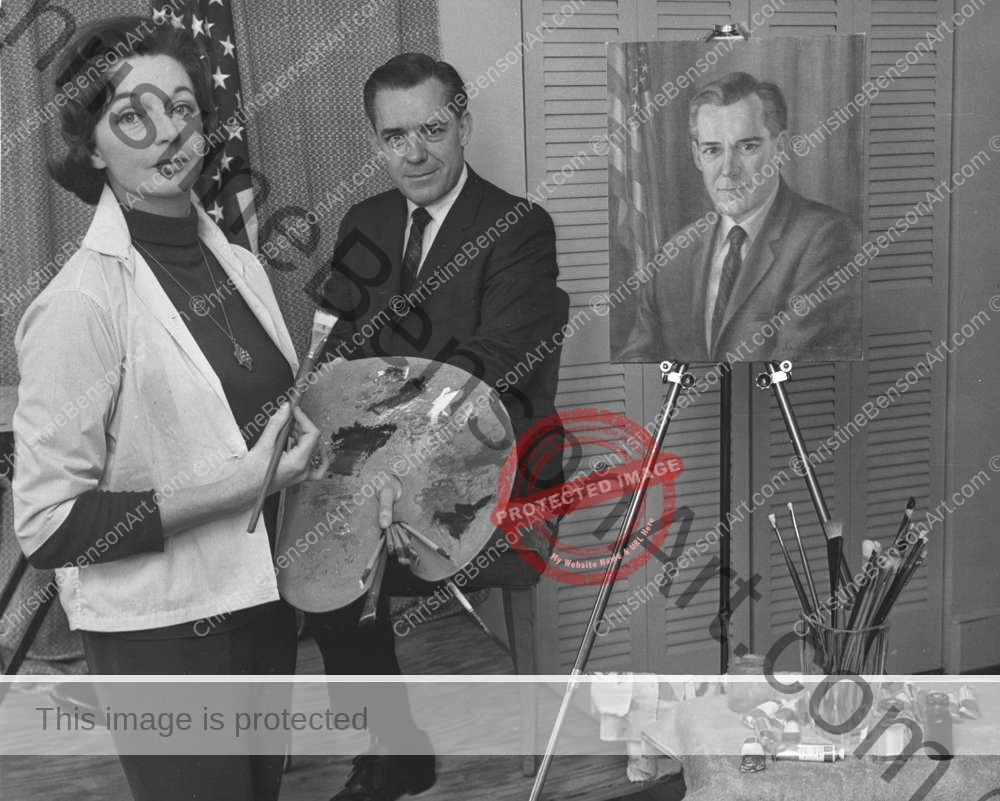
During this time in England, many of her paintings were accepted in local juried shows and she had a few solo and two person exhibitions but she didn’t really manage to break out of the limited local market. In 1967, Christine accepted Benny’s invitation to come to Washington DC. He used his work connections to introduce her to some Congressmen with the idea that she could paint their official portraits. Among others, she painted portraits of Congressmen William Broomfield and Francis Bolten. She also completed a large portrait of a new friend, Jeanne Morrison. While pleased with her own work, all the noise, concrete and crowds of people in the city were too much for her and on the verge of a relapse into her agoraphobia, she abruptly left to escape back to the quiet of the seaside town of Bournemouth.
Once back in England and accepting that she was unable to endure life in the US to make a living, she supplemented her income as an art teacher for the A level courses at Marydale Convent School, Highcliffe-on-Sea, Hampshire. In 1969, her eldest son, Christopher, left for the US where he enrolled at the University of Ohio, in Athens, Ohio. Part of the divorce agreement was that Benny was willing to pay for his sons’ university education but only if they attended university in the US.
In 1969, she took a second summer holiday to the south of France to visit her old friends, the Jackson-Pownalls, who lived in Seillans, Var. After the holiday and seeing the approaching empty nest, she decided to move to the South of France where “she could be a warm, poor but appreciated artist rather than a cold, poor and unappreciated artist in England.” She sold her house in England and arranged to move south in August 1970. Her plans entailed buying a new car in Paris, a Renault Quatrelle with the steering wheel on the “other” side. There was no turning back.
New Beginnings, South of France
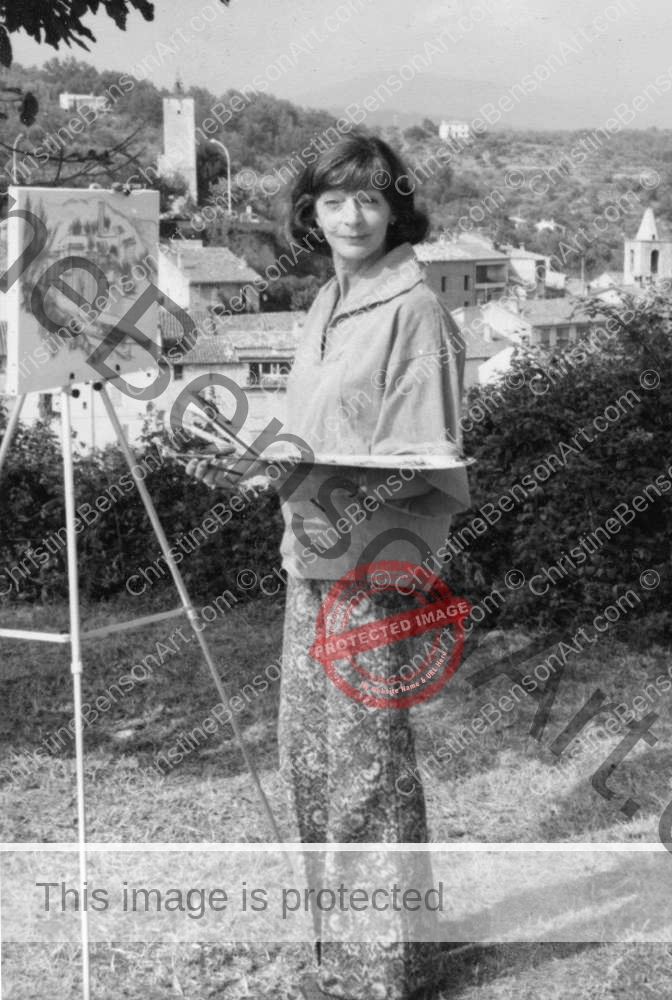
In the south of France, she initially stayed in Seillans with her old friends, the Jackson-Pownalls before finding a small flat in the walls of the nearby village of Bargemon. The flat fitted into the thickness of the 12th century ramparts, with the entrance at street level but with a splendid view from the windows which were located high up in the wall that surrounded the village. She made many new friends with French locals and members of the expat community, including other artists and writers. After a very cold winter, she decided that being in the foothills of the Alps was not ideal and moved to the village of Montauroux, at a lower elevation and more in the valley but still within easy driving distance to Seillans and her local community of friends. The semi detached house had a lovely view of the neighboring picturesque village of Callian. She received some local publicity and arranged a solo show in a gallery in Seillans in 1971. Her second son, Anthony, spent the holidays in Montauroux before leaving for America to attend Duke University, in Durham, North Carolina.
Always one to host impromptu parties and social gatherings, after several very late night parties the landlord asked Christine to find a new place. A contributing factor may have been gossip concerning the “young divorcée” and the landlord’s father who was the subject of a painting she was working on, The Farmer. Consequently the painting remained unfinished. She stayed with friends before leaving for a five week visit to the US to attend her son, Christopher’s wedding in Pennsylvania. The following year, she either house sat or stayed with friends but still continued to paint.
During this time Christine started on a new approach departing from her traditional portraits, she thought were too easily replaced by photographs. She began to introduce symbolism and surrealist elements into her work, for example Fantasy at Dawn which won first prize in portraiture in the New York Grand Prix held in Nice in 1973. She had another solo show in Callian. However, she was not doing well financially and had to supplement her income by cleaning and looking after several houses belonging to Americans and other expats. She had to make a decision about her future: try again to go to the US to make money or stay in France and tough it out. The painting My Dilemma (Le Dilemme) was painted to help answer that question.
Christine found a small flat in Fayence, a slightly larger village between Callian and Seillans. In October, 1972, the day after finishing My Dilemma, she moved into 22 Grande Rue du Château. The grand address notwithstanding, it was very modest. The front door was on the second floor of the building which opened to a flight of stairs to the bedroom and studio. The living area with a tiny kitchen was above and the selling point was the fabulous view looking down the Grande Rue du Chateau and out over the valley.
Christine was now 43, this would be her final move and the start of one of the most productive periods in her artistic career. Over the next ten years she worked diligently at promoting her art by both entering exhibitions in the larger towns and the big cities of Nice and Cannes, as well as working with the local artists and participating in street exhibitions in her own and other villages in the immediate area. She exhibited at the Summer Salon in Cannes; had an Exhibition in Grasse, and in 1973 won the Premier Prix for Portraiture in a major exhibition in Nice.
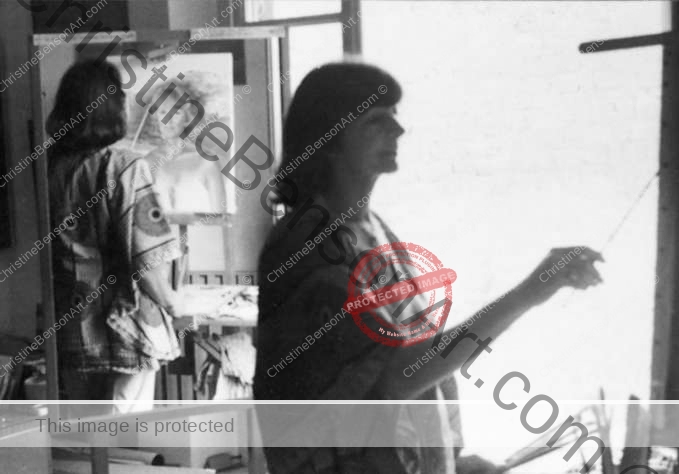
In 1975, she was awarded the “Diplôme d’Honneur, Grand Finaliste et Voix du Jury” at the 11th Grand Prix International de Peinture de la Côte d’Azur plus another “Diploma D’Onore “ at the Gran Premio dei Sette Colli di Roma in Rome, showing “Quo Vadis”. In 1978 Christine and her friend and neighbor Sybille, mounted a two person exhibition in Draguignan hosted by Var Matin, the newspaper for the Department of the Var or local province. In March, 1979 she won the “Diplôme Grande Finale” at the 15th Grand Prix International de Peinture de la Cote d’Azur for the pair of Ondine paintings. In the following month she won the Bronze Medal at the Grand Prix International Peinture de Sud at Juan-les-Pins, and was one of thirteen artists chosen from the Var to exhibit at the Artistes Du Sud De La France exposition in Montmartre, Paris. For this she was awarded the Diploma of the Society of Contemporary Artists.
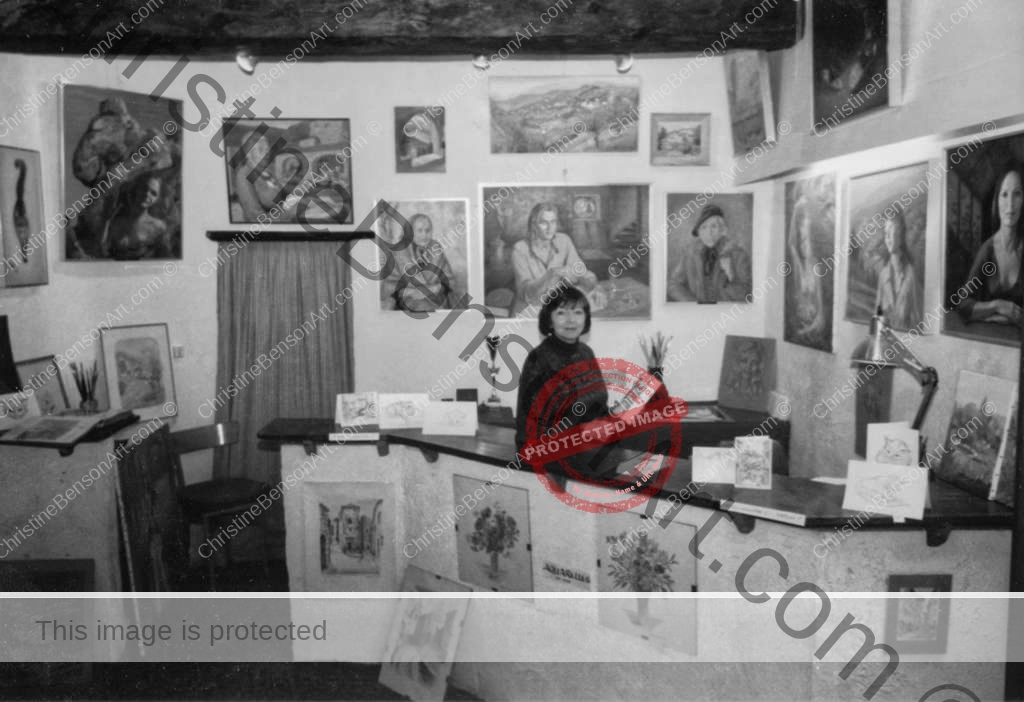
In 1981, at the age of 53 she had a heart attack and fell down the stairs in her flat, subsequently she underwent quadruple bypass surgery. Her recovery was slow and she realized that she would no longer be able to haul her canvases around to exhibitions and teaching demonstrations as before. While looking around for a more permanent gallery space, she discovered a possible solution close at hand. Below her flat at street level, there was an unused “cave” or garage storage area. She negotiated with the landlord to convert this into a small atelier and gallery space, only needing new front glass doors, lighting fixtures, a counter and a lot of whitewash. The “shop” as she called it, opened the following year in 1982. Christine continued to submit paintings to exhibitions, although she was known to have carefully painted over the signature dates of some of her earlier work, in order to submit them to contemporary shows. In December 1981, the Society of Contemporary Art awarded her Le Diplome de Medaille d’Argent, (Silver Medal Diploma). In April 1982, she won another Medal and Diploma d’Honneur with the Societe des Beaux Arts, Salon de Printemps de St. Raphael.
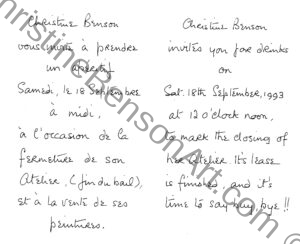
However, the little gallery proved to be a bit of a double edged sword. It did provide a fixed location for sales and was on the main route for tourists walking up to see the panoramic view but this required time spent minding the shop and greeting visitors which took time away from painting. Christine also found that to cater to tourists she needed to produce smaller paintings, landscapes and inexpensive watercolors, cards and simpler line drawings. However, she continued with portrait commissions and teaching sessions. In 1993 at the age of 65 with increasing angina pain and decreasing returns, she gave up the shop.
Retirement and Death
Christine never officially retired although her productivity was greatly diminished and in her final years she only seemed interested in painting flowers . On July 10th, 1995 at the age of 67 she passed away at a hospice in Cannes from cardiac complications relating to cancer of the esophagus. Abiding by her wishes, her ashes were spread under the cherry tree in the garden behind her flat.
